iPhone 6 lifts Apple to biggest profit of any company in history
Apple beats previous records set by BP and ExxonMobil thanks to surge in demand for the iPhone 6
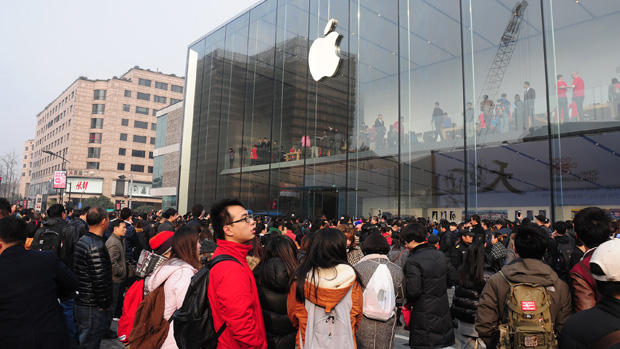
iPhone 6: what to expect
9 September
As the world's technology press descends on Cupertino, California, for the launch of the iPhone 6, the Apple rumour mill has gone into overdrive. In the year since the relatively low-key launch of the iPhone 5S and 5C, rumours have come and gone about the new specs and features likely to find their way into its successor.
While some of it seems to be based on wishful thinking, much is likely to prove well founded. Here is our round-up of the most frequently discussed iPhone 6 specs, and how likely they are to make it into production.
The Week
Escape your echo chamber. Get the facts behind the news, plus analysis from multiple perspectives.

Sign up for The Week's Free Newsletters
From our morning news briefing to a weekly Good News Newsletter, get the best of The Week delivered directly to your inbox.
From our morning news briefing to a weekly Good News Newsletter, get the best of The Week delivered directly to your inbox.
iPhone 6 launch date: Analysts are expecting two versions of the iPhone 6, but it is unclear whether both will make an appearance tonight. It'll be a huge surprise if Apple doesn't produce a 4.7-inch device, but some analysts also expect to see a larger, 5.5-inch handset. Others think that the bigger iPhone 6 will not appear until later in the year. It's also unclear when the new phones will go on sale, but 19 September is the date most frequently predicted.
iPayments: Recent reports suggest that Apple is working on a mobile payments system that will be unveiled alongside the iPhone 6 on 9 September. "Apple has reached an agreement with American Express to work together on its new iPhone payments system," Re/code reported, and Bloomberg later added that Visa and Mastercard have also signed up. The system is likely to use near field communication (NFC) technology, which transfers data to be transferred between a device and a reader when the two are held against each other. The iPhone 6 would therefore work in the same way as the contactless debit and credit cards which have recently entered circulation.
Sapphire crystal: the use of sapphire crystal (also known as sapphire glass) for the iPhone 6 screen has been one of the most persistent rumours about the new handset. Apple is known to have invested heavily in the super-strong manmade material, which is resistant to scratching and bending, but recent reports suggest that it has been having trouble making it in sufficient quantities – and at sufficiently low costs – to furnish an iPhone production run of 100 million units or more. The Guardian recently suggested that Apple may end up using a blend of glass and sapphire crystal.
A Liquidmetal shell: As Apple strives to make the new handset as slim and strong as possible, some commentators have speculated that it may turn to Liquidmetal, an alloy that's stronger than aluminium. In theory that would mean the handset could be lighter and slimmer without skimping on strength or build quality, but in practice it seems unlikely. Although one of the inventors of Liquidmetal predicted two years ago that Liquidmetal cases would be possible by mid-2014, its use has so far been limited to small components.
A free daily email with the biggest news stories of the day – and the best features from TheWeek.com
Liquidmetal components: This is much more likely. Documents published by Apple-watching website MacRumors, suggest that the alloy could be used in buttons and switches in order to toughen up what have often proved to be weak points on previous iPhones.
Aluminium frame: Although Liquidmetal may be off the cards, most of the leaked images and technical drawings suggest that Apple will adopt an all-metal rear frame for the iPhone 6. Previous iPhones have made either extensive or decorative uses of glass, but this year's preview shots appear to show a rear panel fashioned entirely from aluminium – with a cut-out for the Apple logo.
Super-slim frame: Whatever it's made from, most commentators expect the iPhone 6 to be noticeably slimmer than its already svelte predecessor. A few months ago some were predicting a depth of just 6mm, but specs supposedly leaked by Amazon in recent weeks suggest we can look forward to a 7mm iPhone. The slender dimensions are apparently causing problems for component-makers: the difficulty of making a battery that's just 2mm thick has reportedly led to production delays.
A8 chip: Concerted speculation that the new device would include a revamped processor has been "confirmed" by Venturebeat. "The A8 will run at a frequency of 2.0 GHz per core and will create noticeably faster response time and graphics rendering in the new phones," its source says. "By comparison, the A7 chips in the iPhone 5 run at only 1.3GHz per core." Even if those details prove wide of the mark, a newer, speedier chip is a safe bet: Apple is unlikely to build an all-new phone around old technology.
13-megapixel camera: There has been comparatively little speculation about the iPhone 6 camera, but tentative reports out today suggest that Apple may build in a 13-megapixels sensor capable of recording high-resolution 4K video. "Apple is well-known for investing millions into its camera sensor, though the company has always refrained from entering the megapixel count race because adding more megapixels tend to have an negative effect on the low-light performance," Tech Times says. But the website sounds a note of caution: "The original source comes from a Chinese web forum, which may not be the best place to find legitimate iPhone 6 leaked information."
Optical image stabilisation: MacRumors says the bigger of the two iPhone 6 models "may include camera improvements in the form of optical image stabilisation with modules produced by sensor company InvenSense". Camera performance is becoming increasingly important at the top end of the smartphone market, and analysts suggest that optical stabilisation, which reduces image blur, could help to justify a larger price tag for the 5.5-inch iPhone 6.
A curved screen: At the end of last year Bloomberg carried a report predicting the next iPhone models would have screens that curved down at the edges. Curved screens are said to be more durable, more comfortable to use, and better suited to watching videos and playing games, according to Sky News. This would be a bold move for Apple, which usually likes to stand back and see how other phone-makers fare with new, risky technologies – and more recently a source told The Wall Street Journal that Apple has no plans to make use of curved glass. However, despite all the leaked images apparently showing the iPhone 6 with a flat screen, rumours of curved glass have resurfaced, most recently in the Daily Mirror.
Quantum dots: This is probably a technology for future handsets, not the iPhone 6. Patent filings suggest Apple is experimenting with tiny crystal semiconductors just a few thousandths of a millimetre across, which could improve the colour and sharpness of mobile screens. "The techniques Apple describes would let its screens not only show colours more accurately," Business Insider says, "but also show a wider gamut of colours." The publication had predicted in March that the quantum-dot screen may be ready this year, but no further reports of the technology have emerged.
Battery life: Mixed signals have emerged about the iPhone 6 battery life. On the positive side, analysts have pointed to iOS 8, Apple's new operating system, and its new A8 processor as evidence that the company is paying more attention to power consumption. The chip, says 9to5Mac.com "adds significant performance and efficiency enhancements in order to improve the iPhone’s battery life". On the other hand, more recent reports suggest that the slim frame of the new phone has forced Apple to adopt a battery that is just 2mm thick. Taiwanese sources suggest that the new battery has a "similar capacity" to its predecessor, which may dash hopes of significantly improved performance.
Eye-tracking: Some rumours suggested that the iPhone 5S would be eye-controlled, allowing users to scroll through pages without touching the device. When the technology failed to materialise in the last model, hopeful observers shifted their attention to the iPhone 6.
NFC: Another long-predicted feature, Near Field Communication or NFC would allow the phone to act as a payment system. Users would wave their handsets over a receiver to transfer money in shops and restaurants, or between friends. Several Android and Windows Phone devices already support NFC payments, but Apple has yet to make the leap.
Health monitors and apps: Apple has already unveiled its new operating system, iOS 8, and what we've seen so far suggests that Apple is turning its attention to health and fitness. Smartphone accessories such as the Fitbit and FuelBand have proven the demand for health-monitoring devices, and reports suggest that the iPhone 6 will be able to keep track of its owners pulse and body temperature, as well as other metrics. These features may work in conjunction with the long-awaited Apple iWatch.
Price: Financial analysts suggest that the iPhone 6 will be more expensive than its predecessors, in part because of the cost of new components, and in part to re-establish the profit margin eroded by last year's upgrade. When Amazon Japan apparently leaked details of the new device last month, the price, which was the equivalent of £100 higher than a similar iPhone 5S model, took many commentators by surprise. It's unclear whether the leak reflected genuine pricing information, or even if it was a way for Apple to test reaction to a price rise.
Production run: After relatively minor iPhone upgrades last year, analysts expect this year's more substantial changes to create unprecedented demand. According to the Wall Street Journal, Apple "is asking suppliers to manufacture between 70 million and 80 million units combined of two large-screen iPhones with 4.7-inch and 5.5-inch displays by Dec. 30". That's substantially more than the 50 to 60 million iPhone 5S and 5C production run last year, and a huge leap from the 35.2 million iPhones sold in the three months to June.
iPhone 6: battery life hopes rise on launch day
9 September
With Apple expected to unveil the iPhone 6 today, hopes are rising that the new model will offer substantially improved battery life.
Super-tough screens, integrated payment systems and a range of health-monitoring apps have all been predicted for the new handset, but potential customers may be just as pleased that Apple is working on something more fundamental – a battery that lasts.
Analysts anticipate that the iPhone 6 will come in two sizes – one, with a 4.7-inch screen that will be available within days, and another, with a 5.5-inch screen, which may not go on sale until later in the year.
Owners of existing iPhone often complain that their devices barely make it through the day without needing a recharge.
It's a problem that affects all smartphones to some extent. Phone-makers say customers demand light, slim phones that limit battery size and capacity – as well as big screens and powerful processors, which drain power quickly. By contrast, the simpler, stouter phones available a decade ago could go as long as a week in between charges.
The current iPhone, with its small four-inch screen and slim frame, has less room for its battery than most of its competitors. Unlike Android phones, it also provides no way to see which apps are sapping power, so that users can switch them off to conserve battery life.
Evidence emerged earlier in the summer that iOS8, the new operating system that will debut with the iPhone 6, will give Apple owners that option for the first time.
"A presentation slide shown during the tech giant’s Worldwide Developer Conference revealed the next-generation software will monitor battery usage by app," the Daily Mail reports.
"By monitoring which apps use the most power, Apple users will be able to keep a closer eye on their battery life and know which services to close, in order to extend it."
Previously 9to5Mac.com had reported that the iPhone 6's new processor, known as the A8, will also help to extend the life of the battery.
"Sources say that Apple has developed a new A8 system-on-a-chip for the next iPhone that focuses on marginal speed improvements rather than core architectural changes, but adds significant performance and efficiency enhancements in order to improve the iPhone’s battery life," the website reported.
More recently, leaked specification for the iPhone 6 suggest that both models will feature improved battery capacity, which is measured in milliamp-hours (mAh).
"A capacity of 2,915 mAh [for the 5.5-inch model] would be much greater than that of the 1,560 mAh battery found on the iPhone 5s and the rumored 1,810 mAh battery said to be included on the 4.7-inch iPhone 6," Macrumors reports.
Apple-watchers responded enthusiastically to the report. Daniel Sparks, writing for the financial website Motley Fool, said: "As both an Apple customer and an investor, I hope the company can deliver this rumoured 2,915 mAh battery, as well a cutting-edge innovation in battery conservation, which could finally serve up some true all-day battery life."
But he warned that an 1,810 mAh battery for the 4.7-inch iPhone 6 would come as a "major disappointment" and would leave Apple lagging behind its rivals – and iPhone users scanning the room for a power cable.
iPhone 6: why Apple's new phone may disappoint
7 September
Analysts have warned that the iPhone 6 may fail to live up to its pre-launch hype when the new phone is finally unveiled on Tuesday.
Expectations have been running at fever pitch and Apple shares reached a record high two weeks, as Apple investors looked forward to the launch of a substantially updated handset. However, they fell shatply last week and closed on Friday below the psychologically important $100 mark, which they had breached in mid August.
The iPhone 6 is expected to include a faster processor, slimmer frame, larger display and more scratch-resistant screen – as well as a slick new design. Demand is expected to be high and Apple is believed to be gearing up for a record production run of 70 to 80 million units by the end of the year.
But analyst Gene Munster of Piper Jaffray says that early sales of the iPhone 6 may compare unfavourably with those of its predecessors.
"In the near term, we caution that there will likely be noise in the opening weekend iPhone 6 sales numbers," he said, according to Business Insider.
His reasoning is that last year Apple launched two new iPhones, the 5S and 5C, and immediately took the previous model off sale. Between them, the two new models sold nine million units in three days.
Munster predicts that the iPhone 6 will sell 6.5m units in its first three days on the shelves – more than the 5.4m 5S phones sold in the same period last year, but significantly down on the combined figures for both new phones.
Apple is eventually expected to bring out two versions of the iPhone 6, but most commentators now expect to see only a 4.7-inch version of the device at the launch event on 9 September.
A larger model, possibly with a 5.5-inch screen is predicted for later this year.
After peaking at $103.30 on Tuesday, Apple shares have fallen sharply in recent days, recording a 4 per cent drop yesterday.
"Just days before the launch of a new iPhone, Apple shares had their worst day since January," the Daily Mail reports, "with one brokerage warning of a stock downgrade unless its new products show better promise for profit growth."
An analyst from Pacific Crest Securities advised investors to sell Apple shares and bank their gains "unless next week's event details massive incremental profit opportunities" – in other words exciting new products.
But most analysts remain bullish about Apple. Even Munster predicts that the company will rebound from unflattering sales figures and short-term profit-taking.
These factors "may prove to be a speed bump to shares," he says, but "we expect additional product launches and the platform theme to move shares higher through year-end."
Regardless of any misgivings in the financial markets, grassroots excitement about the iPhone 6 shows no sign of abating. Yesterday queues had already begun to form outside the flagship Apple store in New York, even though the phone is unlikely to go on sale until at least 19 September.
The Sydney Morning Herald reports that Australian iPhone enthusiasts have been engaging the services of "professional queuers" to stand in line for the new device.
"By Friday, the number of ads looking for professional queuers at online tasks marketplace Airtasker had soared, along with the premium, with some consumers advertisers offering [Aus]$200 for the privilege," the paper reports.
iPhone 6: how iPayments could replace credit cards
3 September
The new iPhone 6, which Apple is expected to unveil a week today, will come with a built-in "iPayment" system that could end the need to carry multiple credit and debit cards, according to the latest reports.
The system would let a user connect his or her iPhone 6 to a range of accounts, and then make payments by placing the handset on a reader to check out. Transactions would be authorised using the iPhone's Touch ID fingerprint reader.
Many commentators welcomed the development, but some suggested that the market is still not ready for smartphone transactions in physical stores. Nevertheless, the big players in the payment processing business appear keen to sign up for the new system.
"Apple has reached an agreement with American Express to work together on its new iPhone payments system," the technology news site Re/code reports, citing "sources familiar with the talks".
Bloomberg later reported that Visa and Mastercard are also onboard, and added more technical details about how the system will work.
"The new iPhone will make mobile payment easier by including a near-field communication chip for the first time," it says.
Near-field communication (or NFC) allows data to be transferred between a device and a reader when one is placed close to the other - allowing phones to be used in the same way as contactless debit cards or Oyster cards on the London transport network.
NFC is not a new technology, but has yet to enter mainstream use despite its inclusion on many rival phones. Each of the past few iPhone launches have been accompanied by rumours that this would be the model to include NFC, but those hoping to see Apple adopt the system have always been disappointed.
And writing for Forbes, Steven Bertoni argues that "humans aren't ready for mobile payments" yet.
"Card-readers and payment equipment are costly," he says. "No business owner is looking to replace a system that already works. ... For the customer and retailer to make a switch, the new technology must be vastly better than the old."
He quotes a former PayPal president who says that when mobile payments can offer a significantly faster and more personalised transaction, their mainstream adoption will become more likely.
On the other hand, fears of fraud is likely to be a key concern for both customers and retailers, but according to Re/code the technology will prove secure. "Industry sources say Apple believes its iPhone payments system will be as least as secure as traditional payment cards," it says.
Commentators say that the appeal of Apple's brand and excitement about the iPhone 6 could help to popularise the technology.
"Apple's large contingent of devoted iPhone users make a mobile-payments system more attractive to a greater number of merchants," says Time. "And the fact that Apple already also has so many iTunes accounts on file means users may be more inclined to try out the service."
According to CNET, 800 million iTunes account holders have entrusted Apple with their credit card details. Those customers are likely to be able to take advantage of the iPhone 6's new payment system without too much form-filling, which often creates an obstacle to new payment systems.
iPhone 6: Apple confirms special event on 9 September
29 August
Apple has confirmed that it will hold a press even on 9 September, at which it is all but certain to present the iPhone 6. Less certain, but also the subject of speculation, are announcements about a large-screened iPad Pro and a wrist-mounted iWatch.
Apple has all but confirmed that the iPhone 6 will make its first official appearance on 9 Septmber, as speculation mounts that it may be accompanied by other new Apple products.
An invitation (below) sent to journalists confirms the date but gives little away about what will be on show. "Wish we could say more" is the teasing strapline.
The press event will take place in Cupertino, the Californian city in which Apple has its headquarters. It will start at 7pm UK time and, if past events are anything to go by, will hold back the most anticipated news until the very end.

Analysts are united in predicting that a 4.7-inch iPhone 6 will be unveiled, with some also expecting a 5.5-inch version of the new handset.
Yesterday, reports began to circulate the long-rumoured iWatch – a wrist-mounted device that works in conjunction with an iPhone – would also make its debut.
And that's not all. "Other products rumoured to be in the works include a 12-inch iPad, an Apple-designed television set and a revamped Apple TV," reports Wired.
Apple never comments on products before their official announcement, but leaked information and images have allowed observers to build up a detailed picture of what they're expecting from the iPhone 6...
iPhone 6 'about to enter mass production'
28 August
The long-awaited iPhone 6 is about to enter mass production and will be ready for its rumoured unveiling in less than two weeks, according to the latest reports.
New images of the handset's packaging published today appear to confirm that Apple fans will get their first glimpse of the new device on 9 September.
The date was first touted a few weeks ago, but last week Reuters reported that problems with the screen had brought production of some components to a halt over the summer (see below).
The news agency's source suggested that the iPhone 6 might be delayed, or that supplies of the new handset could be restricted, after Apple insisted on a new design for the ultra-slim screen.
Now, however, a photograph published by the French website Nowhereelse.fr shows an outline of the phone with "Tuesday September 9" printed across the screen. Last year the site published a similar image which correctly predicted the launch date and other details of the iPhone 5S.
The report adds to a growing consensus that the iPhone 6 will appear in less than two weeks. Yesterday AppleInsider said the device "has entered the 'product validation test' stage, which is the final step before mass production".
The claim is based on comments made by Xiang Ligang, a Chinese telecoms analyst who quoted sources inside Apple's Foxconn factory in China.
Xiang also said that "manufacturing is 'not a problem' at this point, and the handset remains on track for its rumoured September release", according to AppleInsider.
Two new iPhones are expected this autumn, one with a 4.7-inch screen and a larger one, possibly stretching to 5.5 inches. It is not clear whether both devices will be launched at the same time, or if only the smaller of the two will appear on 9 September and the larger phone will follow later. The smaller phone at least is likely to go on sale within a fortnight of the launch event.
Some sources have suggested that Apple will also unveil a wrist-mounted device, widely referred to as an iWatch, at the September event. Rumours have long suggested that the company is working on a wearable version of its flagship phone, but firm predictions have been thin on the ground.
iPhone 6: Screen flaw 'could delay launch plans'
22 August
Apple's plans to launch an ultra-thin iPhone 6 next month may have to be revised, according to reports that technical problems have left the company "scrambling to get enough screens ready".
Most industry-watchers expect the iPhone 6 to be unveiled on 9 September, with sales likely to begin about ten days later.
But today Reuters reports that Apple had to change the design of the new model over the summer, preventing it from building up a stockpile.
"Two supply chain sources said display panel production suffered a setback after the backlight that helps illuminate the screen had to be revised, putting screen assembly on hold for part of June and July," Reuters reports.
One of the sources claims that Apple had tried to use a single layer of backlight film in an attempt to keep the iPhone 6 as slim as possible. It later emerged that the screen was not bright enough "and the backlight was sent back to the drawing board to fit in the extra layer."
Although the problem is now understood to have been resolved, the delays could limit the supply of the iPhone 6, which is expected to be in heavy demand.
According to the Wall Street Journal, Apple is asking suppliers to make between 70 million and 80 million iPhones before the end of the year, a significant increase on the 50 million to 60 million initial production run for the iPhone 5S and 5C last year.
"It's unclear whether the hiccup could delay the launch or limit the number of phones initially available to consumers," Reuters says.
Apple share price climbs in expectation of iPhone 6 launch
21 August
Investors have expressed their confidence in the forthcoming launch of the iPhone 6, pushing Apple shares through the $100 barrier to a new record of $100.53.
The previous record was set at a similar point in the product release cycle two years ago, when shares reached the equivalent of $100.30 just before the release of the iPhone 5.
The actual share price then was $702.10, but since then each share has been split into seven.
Analysts predict that iPhone 6, expected next month, will represent a significant advance on the current model, which received only a minor refresh last year. A larger screen, slimmer frame, faster processor and longer-lasting battery are expected to be among the improvements.
As a result demand is expected to be strong and Apple is reported to be preparing for a record production run of the new handset.
The Guardian says a series of bullish tweets from an influential investor has also driven up Apple's value.
"The shares were also boosted by tweets from activist investor Carl Icahn, who bought into Apple last autumn and added to his stake earlier this year," the paper said. "He called his investment in Apple a 'no brainer'."
iPhone 6: will new phone come with scratchless sapphire screen?
15 August
In the swirl of rumours surrounding the iPhone 6 – the next incarnation of Apple's flagship handset which is expected to launch next month – one of the most persistent claims was that the new phone would come with a sapphire glass screen.
Sapphire glass, a manmade material, is one of the toughest substances around. Resistant to both shattering and scratching, technicians have to use diamond-tipped tools to cut or engrave it.
It is, therefore, the ideal material for a smartphone screen, as the video below appears to show. Despite a sustained assault with keys and even knives, the screen emerges unscathed.
Apple already uses sapphire glass for the camera lens cover and fingerprint reader on the iPhone 5S, but no one has yet been able to manufacture it in large enough quantities – or at a low enough cost – to make it viable as a screen coating.
Then, in February this year, 9to5Mac reported that Apple had "procured enough sapphire crystal furnaces to make 100-200m five-inch iPhones". GT Advanced, an Apple supplier, had bought new equipment that would allow it to make slabs of the material large enough for smartphone screens.
As weeks went by, the hope that the iPhone 6 screen would be more-or-less indestructible morphed into an expectation, and then a near certainty.
When the video below was posted on YouTube last month, it seemed to confirm that sapphire glass on the iPhone 6 was a done deal.
But then, two weeks ago, reports emerged that Apple had been forced into a rethink.
"Disappointingly low yield rates of sapphire glass mean that while the material may be used for the display of later versions of the handset, the launch model will use another reinforced form of glass," the Daily Telegraph said.
The claim was based on research by TrendForce LEDInside, which said that Apple was struggling to produce enough sapphire glass to keep pace with expected demand.
"Analysts say the new smartphone won't come with the new screen glass because they can't make it quick enough to meet deadlines," reports the Daily Mirror.
As well as being slow and expensive to grow, "it is also very difficult to cut, grind and polish", one expert told the Telegraph. "Diamond tools have to be used for all of these processes."
Recent statements from GT Advanced Technologies, the company that supplies Apple with sapphire glass, are inconclusive but seem to support the theory that we may have to wait until next year for a sapphire-coated iPhone 6.
"Progress has admittedly been slower due to some of the start-up challenges that we've faced," Tom Gutierrez, the company's CEO said. He told investors that the factory would reach "full operational efficiency" in early 2015.
Now the Wall Street Journal implies that Apple has yet to make a decision on what kind of screen coating to use in the iPhone 6, saying the company is "considering using sapphire screens in more expensive models of the two new, larger iPhones it plans to debut this fall, if it can get enough of the material."
If that report proves correct, Apple is cutting things fine: the grand unveiling is expected in just three weeks.The main stumbling block remains pricing: an analyst tells the paper that a sapphire screen will cost Apple $16 to make, compared with about $3 for the existing Gorilla Glass unit.
The report also casts some doubt on the seemingly miraculous properties of sapphire glass.
"Sapphire is scratch-resistant," it says, "but it isn't clear if the material will better protect against screens breaking, since sapphire's strength depends on its thickness and cut. Sapphire also is denser than glass, which will add to the phone's weight."
Nevertheless, for many the YouTube video below remains convincing evidence that Apple has some kind of breakthrough screen-protection technology ready to grace the iPhone 6.
And everyone agrees that a scratchless screen would boost Apple's sales and reputation for innovation.
The technology, TechCrunch says, would "give Apple a considerable advantage over the rest of the market, which finally mostly uses Gorilla Glass, the material it pioneered with its original iPhone but which it now looks ready to leap beyond".
iPhone 6: new leak shows phone boxed and ready to go
12 August
With the expected iPhone 6 announcement now less than a month away, new images of the handset have appeared online.
The leak, supposedly from someone given the device in advance for testing, shows the iPhone 6 boxed up in retail packaging, apparently ready to go on sale.
Published on TechRadar, the three images show a white and silver handset which looks similar to the device seen in other leaked images and diagrams in recent weeks. But a growing number of observers are suggesting that they do not show the iPhone 6 that Apple is expected to unveil next month.
TechRadar says that although it cannot guarantee the veracity of the images, it believes they are genuine. "After having checked EXIF data, photo manipulation and doing a little background check on our source, there's no reason for us to believe that these are fakes," it says.
But even allowing for the relatively poor image quality, the device in the photographs does not seem to have the high-quality finish associated with Apple products.
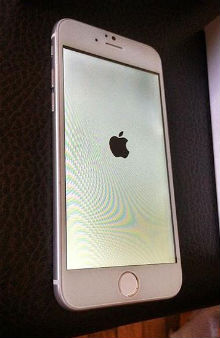
Image from Techradar
They also contain inconsistencies that have led some commentators to doubt that they are genuine. To start with, the image on the front of the box seems to show Apple's current operating system, iOS 7, not the new iOS 8 that will be installed on the iPhone 6.
"One point of note that could work against the veracity of the images is the seeming lack of iOS 8," says the Sydney Morning Herald. "Further cause for scepticism are the raised volume buttons and visible bezel (the black border around the screen), both of which are inconsistent with previous reports."
The Guardian suggests that the images are genuine but the phone is not.
"The pictures seem too imperfect to simply be a photoshop, and a few images – particularly the moire effect on the screen itself – would be hard indeed to fake," it says. "Instead, it seems likely that the device is a knock-off iPhone 6 of the sort already produced and sold in Asian markets."
It points out other apparent shortcomings of the phone seen in the photographs, noting that the plastic strips embedded in the aluminium frame of the handset are larger than those of the iPhone 5S.
And it also questions the supposed source of the leak, described by TechRadar as a "beta tester". According to The Guardian, Apple does not provide its testers with boxed devices, preferring to hand over phones in nondescript packaging designed to conceal their contents.
"It would a be a major change for a company with such a dedication to secrecy to lift such practices," the paper said.
Apple is expected to unveil the iPhone 6 on 9 September (see below), with at least one new model going on sale ten days later. Most analysts expect Apple to build a larger model, probably with a 5.5-inch screen, alongside the standard 4.7-inch handset, but it is not clear whether both models will go on sale at the same time.
Concept iPhone 6 image (top) by Martin Hajek
iPhone 6: Super-slim phone 'to launch on 9 September'
9 August
Most Apple-watchers now expect that we will get our first official glimpse of the iPhone 6 in a month's time, with 9 September emerging as a firm favourite for the announcement.
The company is expected to launch two models of iPhone 6, a 4.7-inch version and one with a 5.5-inch screen, which may follow later in the year. According to reports from Venturebeat, both models will be built around a new A8 processor that will deliver significantly improved performance over previous models.
Until last week the most widely tipped launch date had been 19 September, but reports now suggests that Apple may unveil the iPhone 6 a couple of weeks earlier.
"Apple has scheduled a big media event for Tuesday, Sept. 9 — a date to which Apple numerologists will strain to attribute significance," says Re/code, a technology website run by former Wall Street Journal reporters. "As with September events past, the focal point of this one is to be Apple’s next-generation iPhones."
Apple-watching site Macrumors describes the 9 September launch date as "all but confirmed".
Yesterday new details about the new handset have emerged, with iPhone accessories company Feld & Volk publishing images believed to show parts of the iPhone 6 casing and camera assembly.
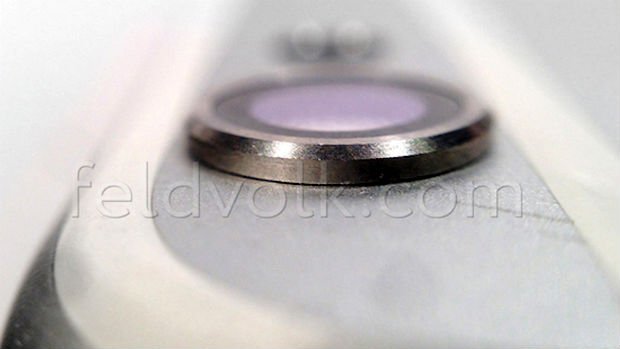
The frame is thinner and larger than the existing model, Business Insider says, and features the same curved edges we've seen in photos over the past several months".
There is some doubt about whether the images show the 4.7 or 5.5-inch model. Leaked technical drawings have previously suggested that the camera lens on the smaller phone would be flush with the rear frame, but the photo above clearly show a protruding lens. That has led some commentators to conclude that latest leak shows the larger of the two iPhone 6 models.
Despite the increasingly detailed leaks, the date on which the iPhone 6 will go on sale remains the subject of controversy. In the past few weeks, analysts have been predicting a mid-October launch, with Apple Store managers apparently having been told that 14 October will be an "immense" day.
But that claim has raised eyebrows: 14 October is a Tuesday, and new iPhones usually go on sale on a Friday.
Now the Daily Telegraph suggests that if the iPhone 6 is unveiled earlier than previously expected, its launch could also be brought forward.
"Judging by past releases, the iPhone 6 could then go on sale to the public from Friday, September 19," the paper says.
Writing in Forbes, Chuck Jones suggests that the sales forecasts Apple issues to investors supports the theories that the company is planning to have the iPhone 6 on sale well before the end of Spetember. Otherwise, he says, it won't be able to meet the targets it has set itself.
"Apple's revenue guidance for the September 2014 quarter is $37 to $40 billion, which would be a 3 per cent increase year over year at the mid-point and 7 per cent at the high-end," he writes. "To hit these numbers the company has to announce and ship new iPhones early enough as its quarter ends on Saturday, September 27."
Jones says that Apple could meet the lower end of its target with only a 4.7-inch phone. If it launches the larger phone simulatneously, he says, the higher end of the range is well within its reach.
Apple never comments on speculation in the run-up to product launches.
iPhone 6: Factory explosion may delay launch
5 August
At least 75 people have been killed and hundreds more injured by an explosion at a car part factory in China.
Industrial accidents are not unusual in China – in 2012 more than 70,000 people died – but this one has made headlines in the west because it might delay production of the iPhone 6.
Apple is expected to unveil the handset in mid September, and recent reports have suggested that it will go on sale about a month later. But those forecasts are now in doubt.
"It's thought the delays could impact on Foxconn, a key part of Apple's supply chain, who recently took on 10,000 new staff to cope with the demand for iPhone 6," the Daily Mirror reports.
The factory affected by the blast is unconnected with the Apple supply chain, but in response to the accident Chinese authorities have ordered production to a halt at any plants carrying out similar work.
"The dust explosion at a car hub cap factory has triggered a nationwide halt at factories involved in metal polishing while health and safety checks are performed," the Mirror says.
Aluminium alloy used in the iPhone body is polished at Foxconn, according to the New York Post. In May 2011, three people died in an explosion at Foxconn's metal polishing workshop, the South China Morning Post reports.
The paper says that the process of polishing metal can lead to a build-up of metallic dust containing iron, aluminium and magnesium. "If mixed together at a high enough concentration, a spark could trigger an explosion," it says.
iPhone 6 production is already thought to be behind schedule after difficulties manufacturing the ultra-thin batteries and screens required for the slender new handset.
The battery, which will be just 2mm thick, "is said to be causing production problems because of the fragile nature of such components," the Daily Mail reports.
iPhone 6: Apple 'drops sapphire glass' for October launch
4 August
The iPhone 6 will not feature a sapphire crystal display after all, according to analysts who say they can find no sign of the material in Apple's supply chain.
Persistent leaks and rumours had suggested that the screen of the iPhone 6 will be coated with the super-strong man-made glass, which is second only to diamond in hardness. But now the new handset seems likely to launch with a Gorilla Glass screen, like its predecessors.
Apple has apparently struggled to manufacture enough of the new material to supply what is expected to be one of its biggest ever production runs: the company is believed to be gearing up to deliver up to 80 million of the new phones between launch and the end of 2014.
It is expected to unveil the iPhone 6 in mid-September, and new reports suggest that a 4.7-inch model will go on sale a month later. MacRumors quotes an anonymous source who said that Apple has told its retail store managers to expect an "immense" day on 14 October.
According to TechRadar, "the report has raised eyebrows in many circles, considering every Apple iPhone launch since the first-generation handset in 2007 has taken place on a Friday" – but 14 October falls on a Tuesday.
MacRumors' source says the switch of days will allow Apple to cope with "high customer demand", enabling stores to restock for the weekend. After previous iPhone launches, analysts have suggested that Apple is happy to let demand outstrip supply, as long queues fuel the hype surrounding a new product.
Other commentators have cast doubt on the report, suggesting that the 14 October event may be unrelated to the iPhone 6. Apple is also expected to launch the iWatch – a wrist-mounted smart device – this autumn, as well as new iPads and Macs.
Nor is there any word on when the larger, 5.5-inch iPhone 6 predicted by many Apple-watchers may be released. Recent reports have suggested that it may not appear until next year after problems encountered with manufacturing components slim enough to meet Apple's specification.
Unlike many Apple rumours, including those relating to the launch date, reports that the iPhone 6 would be fitted with a sapphire crystal screen seemed to be grounded in solid, on-on-the-record detail. The company is known to have invested millions of dollars in a company that manufactures the material.
But now analysts say that Apple has been forced into a rethink.
"Disappointingly low yield rates of sapphire glass mean that while the material may be used for the display of later versions of the handset, the launch model will use another reinforced form of glass," reports the Daily Telegraph.
It will still be used in smaller iPhone 6 components, such as the camera lens and fingerprint scanner – which are already fashioned from sapphire crystal.
The report is based on research by TrendForce LEDInside, which says that Apple was struggling to produce enough sapphire crystal to keep pace with expected demand. "Analysts say the new smartphone won't come with the new screen glass because they can't make it quick enough to meet deadlines," reports the Daily Mirror.
A video released earlier this month (see below) showed what many believed to be a sapphire crystal display from an iPhone 6 emerging unscathed from a battery of bending, scratching and stabbing with knives.
But the Telegraph quotes one expert who suggests that the very quality which made sapphire crystal Apple's first choice – its hardness – also contributed to the production problems that have supposedly ruled it out.
As well as being slow and expensive to grow, "it is also very difficult to cut, grind and polish", says Hutch Hutchison, head of design at phone-maker Vertu, which uses the material in its high-end handsets. "Diamond tools have to be used for all of these processes."
iPhone 6: Apple scrambles for 'biggest ever' launch
23 July
Apple is building a stockpile of up to 80 million handsets as it prepares to launch the iPhone 6 – a major upgrade to its flagship smartphone, which remains the company's most profitable product.
Analysts expect two versions of the iPhone 6, both with larger screens than the current four-inch model. The smaller of the two will extend the screen to 4.7inches, while a 5.5-inch model will take on the phone-tablet hybrids known as phablets.
Apple "is asking suppliers to manufacture between 70 million and 80 million units combined of two large-screen iPhones with 4.7-inch and 5.5-inch displays by Dec. 30", the Wall Street Journal reports, quoting "people familiar with the matter".
This compares with an initial production run of 50 to 60 million units of the iPhone 5S and 5C, which Apple launched last autumn. In the quarter to June, Apple sold 35.2 million iPhones.
Demand for the iPhone 6 is likely to be high as the new phone looks set to be a significant advance on its predecessors. Leaked images and videos suggest that, as well as a larger screen, the new phone will offer an ultra-slim seven millimetre frame and a highly scratch-resistant coating (see video, above).
But the slender construction of the new handset is causing a headache for component manufacturers, according to several reports.
The battery, which will be just 2mm thick, "is said to be causing production problems because of the fragile nature of such components," the Daily Mail reports.
And DigiTimes says the technical challenge manufacturing components for the iPhone 6 is denting the profits of parts suppliers. "Apple orders will contribute to component makers' revenues but will not help in increasing gross margins, according to supply chain makers," the website says.
However, the orders are likely to keep suppliers busy. The Wall Street Journal says that ultra-thin screens are proving difficult to build to the required standard, forcing Apple to up its orders.
"To factor in the possibility of a higher failure rate for displays," the paper says, "Apple has asked component makers to prepare for up to 120 million iPhones by year-end."
Figures released by Apple last night revealed that Apple made profits of $7.7bn between April and June this year, a little more than analysts had been predicting.
More than half of the company's $37.4bn quarterly revenue came from the iPhone, and year-on-year sales of the iPad slipped for a second successive quarter. Time attributed slowing demand for tablets to "increased competition from large-screen smartphones", but Tim Cook, Apple's CEO, defended the iPad's performance.
"iPad sales met our expectations," he said. "What's most important to us is that customers are enjoying their iPads and using them heavily."
iPhone 6: super-slim battery to power 7mm iPhone
21 July
Claims that Apple is planning an ultra-thin 7mm iPhone have been bolstered by reports that component makers have been tasked with building a battery just 2mm thick.
The Taiwanese technology news website DigiTimes says "the new iPhones' battery only has a thickness of 2mm, thinner than the 3mm of the iPhone 5-series, but both feature a similar capacity".
Cutting the depth of the battery by a third increases the likelihood that Apple will dub their new handset the iPhone Air, the Daily Mail suggests.
"However, [the new battery] is said to be causing production problems because of the fragile nature of such components," the paper reports.
DigiTimes says the technical challenge of slimming down components for the iPhone 6 is putting a dent in the profits of parts suppliers.
"Apple orders will contribute to component makers' revenues but will not help in increasing gross margins, according to supply chain makers," the website says.
Apple is believed to be working on two versions of the iPhone 6 – one with a 4.7-inch screen and another with a screen measuring 5.5 inches or thereabouts. Current iPhone models have a 4-inch display.
Poor battery life has long been a complaint of iPhone users, but demand for increasingly slender handsets limits the space available for power packs.
Nonetheless, Trusted Reviews says the vagueness around the claim that the new 2mm battery will have a "similar capacity" to its predecessor "could worry some potential owners.
iPhone 6: new software raises hopes of extended battery life
iPhone 6: Amazon 'leaks details of new Apple phone'
15 July
Yet more details of the forthcoming iPhone 6 have been leaked in an apparent breach of secrecy by Amazon Japan.
The online store, Apple's biggest retail partner, appears to have accidentally posted detailed specifications for the new phone, which is expected in September. The post has now been deleted.
If the leaked details are correct, the iPhone 6 will:
- measure 130 x 65 x 7mm
- weigh 113g
- include up to 64GB of memory
- cost 139,999 yen (about £800) for the 64GB model
Those specifications are broadly in line with what analysts' predictions for the smaller of the two new iPhone models – with the exception of the price, which is almost £100 more than the cost of an equivalent iPhone 5S.
The second iPhone 6, which may not be available until later in the year, is expected to have a larger screen.
The current iPhone's four-inch screen is small compared with many of its competitors, but some Apple fans have expressed concern that the iPhone 6 will sacrifice ease of use for a larger display.
Forbes suggests these specifications will offer some comfort to those who worry that the new phone will be unwieldy.
"The dimensions are potentially not as off-putting as feared," it says, noting that the new phone would be just a few millimetres taller and wider than its predecessor. "All this would make one-handed use of the iPhone 6 very feasible."
However, the website warns that these dimensions may prove "too good to be true", given the near certainty that the new phone will have a 4.7-inch screen.
Apple never comments on leaked information about new products.
iPhone 6: smart security identifies 'safe zones'
14 July
Apple has patented a smart security system that may be destined for the iPhone 6 and other mobile devices.
The patent, which was awarded earlier this month, describes software that would alter the level of protection depending on where the phone was.
"For example," Fox News says, "if the device is on your home network, your iPhone would be allowed to bypass typical security measures."
That could mean skipping the auto-lock and passcode barrier so that you had instant access to your iPhone 6 while at home.
Conversely, if you were in an area "deemed to be unsafe for electronic devices", the iPhone would implement more stringent security.
"This could add extra security measures and steps, in addition to the PIN, passcode of fingerprint scanner," the Daily Mail says.
Customised location-based security has been possible on Android phones for sometime, in conjunction with apps such as Tasker, but they have not yet been built into a handset.
Both Google and Apple now seem to be working on ways of integrating smart security with their mobile operating systems. Last year, Google filed a patent for software that seems similar to that described in Apple's more recent filing.
iPhone 6: sapphire crystal screen resists knife attack - video
9 June
The iPhone 6 will have a sapphire crystal display that can resist the most determined attempts to bend, shatter or scratch it, according to a video apparently showing the new handset's screen.
The video (above), posted by technology commentator Marques Brownlee, appears to show the front screen cover being subjected to a range of extreme strength tests. Brownlee says the super-strong display remains unmarked even after sustained attempts to bend it, twist it and scratch it with keys and knives.
Apple has invested more than half a billion dollars in highly scratch-resistant sapphire crystal, which has previously been used in small quantities for the iPhone 5S camera lens. According to some reports, sapphire crystal can survive undamaged even after being rubbed against concrete.
Apple news site 9to5Mac.com reported earlier this year that the company was gearing up production in order to produce enough of the material to use it for the entire screen on its new handset. "Apple just procured enough sapphire crystal furnace to make 100-200 million five-inch iPhone displays in Arizona," the report claimed.
Sapphire crystal is more expensive than the "gorilla glass" used by Apple for previous iPhone screens, leading many analysts to suggest that the iPhone 6 will come with a higher price tag than previous models.
"We see the potential for the iPhone 6 price point to move higher, to avoid the profit margin erosion that occurred when iPhone 5 launched," Chris Caso of Susquehanna Financial Group told Investors.com earlier this year. "When iPhone 5 was launched, Apple's phone margins declined because the new features (most notably the display) added cost to the bill of materials, yet the price point of the phone remained unchanged."
The sapphire crystal video appeared to confirm the suggestion that images widely circulated in recent weeks may not show the final design of the iPhone 6 after all.
As well as the video, new photographs have emerged, apparently revealing a slicker, curvier glass screen than the one seen in previous leaks. Commentators have suggested that earlier images may have shown pre-production dummies that differ from Apple's final specification.
Japanese newspaper Nikkei says that prominent stripes on the back of the phone, said to be part of the antenna, will not be visible in their current form when the handset goes into production.
"The final iPhone 6 may not feature the 'stripes' at all," says 9to5Mac.com, translating Nikkei's report. "These simply mark out an area for glass materials to replace the aluminium frame, just like the iPhone 5s. Another possibility is that the stripe appearance is still present, but the stripes will be made out of attractive highly-polished glass."
Some Apple fans have expressed relief that what they have seen so far is not the finished article.
"For another smartphone company (Samsung, perhaps?) I could imagine this as a legitimate design decision," writes Forbes columnist Antony Wing Kosner. "But for Jony Ive with his diamond cut chamfered edges? Never!"
The most recent images (below), published by 9to5Mac, correspond to the screen featured in the sapphire crystal video and appear to show a much more accomplished device. Only the front screen could be seen, but the polished glass finish and curved edges seem more in keeping with Apple's design-led traditions.
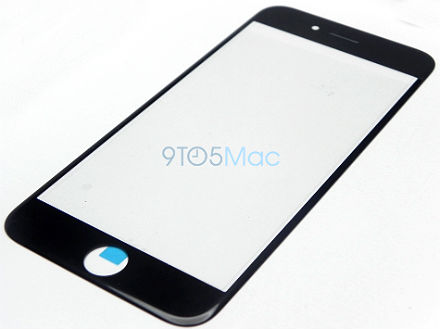
iPhone 6: Apple gears up for 19 September launch
30 June
The iPhone 6 will be unveiled on 19 September, according to reports citing "inside sources" from the Apple supply chain in China.
Deutsche Telekom has previously told customers to expect the new phone on the third Friday in September, which was also the launch date for last year's iPhone 5S and 5C.
Reports from Apple suppliers earlier this week suggested that the iPhone 6 is about to go into production, and appeared to confirm that the new device will come in two sizes – both larger than existing models.
"Apple is ramping up on two bigger devices," Bloomberg reports, quoting "people familiar with the plans". Its sources confirmed previous speculation that the iPhone 6 will be available with both 4.7-inch and 5.5-inch screens, compared with the 4-inch screen of the iPhone 5S and 5C.
But whereas recent reports have suggested that the larger of the two new models would not be available until at least a month after its smaller sibling, Bloomberg's sources say that the "5.5-inch version is also being prepared for manufacturing and may be available at the same time".
After making relatively small changes to the iPhone last year, Apple is gearing up for a much more substantial overhaul this year.
"Hundreds of thousands of new employees have been drafted in by suppliers to meet the expected huge demand," the Daily Mail reports.
Most analysts now expect the iPhone 6 to be unveiled at an Apple event in September, with the new handsets available for purchase soon afterwards.
iPhone 6 'leaked' by Taiwanese pop star
20 June
Last week's iPhone 6 leak came from a Tawanese pop star with a track record for tweeting Apple secrets. This week an Australian blogger with an equally strong record in Apple-baiting has followed suit
The new model is not expected to go on sale in the autumn, but a series of leaked images and information from Apple suppliers in China has provided an increasingly detailed and unusually consistent picture of the new handset.
Most analysts now believe Apple is planning a major upgrade to its flagship handset, with a new look and feel for the iPhone 6, and two different screen sizes – both bigger than the current model's 4-inch display.
The images released by Jimmy Lin on Weibo, the Chinese equivalent of Twitter, appeared to confirm those expectations.

"The reported new model appears to sport a larger display and more softly contoured edges than its predecessor, inside brushed metal casing," the Daily Telegraph reports. " It also appears to have the same touch ID-enabled home button as the iPhone 5S."
Lin himself has little insight to offer about the experience of using the new phone, but he does say that it "offers a good grip", according to Metro. Lin has previously posed with pre-production models of the iPhone 5C and iPad Mini, which turned out to be genuine.
App developers will be pleased to note that the new phone appears to have the same aspect ratio as the current model, despite its larger size. That will make it easier to adapt apps for the new handset.
However, says Forbes, "the significantly increased height will increase concerns that the handset will no longer be the one handed device many users have spoken up for as Android phones get ever larger."
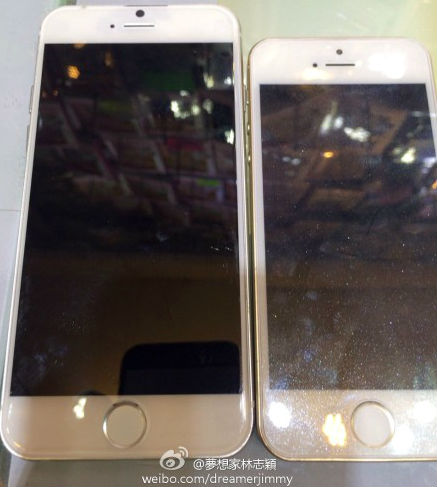
The device shown in the photos corresponds closely with other leaked images that have surfaced on the internet in the past few weeks.
Although it is impossible to confirm whether they are genuine, most commentators seem to believe that the device photographed by Lin is a real pre-production model - or possibly even the final version of the iPhone 6, given Apple's need to build up a stockpile of devices before the launch.
The Australian blogger Sonny Dickson has used the information from these images and other leaks to build high-quality mock-ups of the two iPhone 6 models, which he posted on Twitter over the weekend:
Hello! #iPhone6 pic.twitter.com/5PVLmEKsXs— Sonny Dickson (@SonnyDickson) June 14, 2014
iPhone 6: Apple boss promises 'exciting' launch
11 June
Apple chief executive Tim Cook has whetted the appetite of iPhone enthusiasts with the promise of "exciting products" to be unveiled later this year.
He is almost certainly referring to the iPhone 6, which is expected to go on sale this autumn.
Cooks made the comments to Apple staff during a tour of the company's new campus in Austin, Texas, the Daily Mail reports.
Little solid information is available about the new iPhone – not even its name is certain, with some predicting that the new model will be called the iPhone Air.
Nevertheless, most analysts believe Apple is planning a major upgrade to its flagship handset. They predict a new look and feel for the phone, and two different screen sizes – both bigger than the current iPhone's 4-inch display.
Recent reports had suggested that the bigger of the two models could be delayed until 2015, but Cantor Fitzgerald analyst Brian White said yesterday that a visit to Apple suppliers in China had convinced him that the large-screened phone would also debut this year.
"Our research indicates that Apple will launch the 4.7-inch iPhone 6 in September, and we believe the 5.5-inch iPhone 6 could be announced at a similar time or shortly thereafter in October," he was quoted as saying by technology website BGR. "As such, we are confident that the 5.5-inch iPhone 6 will be launched this year."
iPhone 6: new software raises hopes of extended battery life
10 June
As new details emerge about the shape and size of the forthcoming iPhone 6, potential customers are likely to be just as pleased that Apple is working on something much more fundamental – a battery that lasts.
Supersharp screens, integrated payment systems and even flexible glass have all been predicted for the new handset, but recent reports suggest the company is turning its attention to battery life too.
iPhone owners often complain that their devices barely make it through the day without needing a recharge.
It's a problem that affects all smartphones to some extent. Phone-makers say customers demand light, slim phones that limit battery size and capacity – as well as big screens and powerful processors, which drain power quickly. By contrast, the simpler, stouter phones available a decade ago could go as long as a week in between charges.
Android users have long been able to see which apps are sapping the battery and switch them off to conserve power – but Apple has never included the function.
Now evidence has emerged that iOS8, the new operating system likely to come out at the same time as the iPhone 6, will give Apple owners that option for the first time.
"A presentation slide shown during the tech giant’s Worldwide Developer Conference revealed the next-generation software will monitor battery usage by app," the Daily Mail reports.
"By monitoring which apps use the most power, Apple users will be able to keep a closer eye on their battery life and know which services to close, in order to extend it."
Last month 9to5Mac.com reported that the iPhone 6's new processor, known as the A8, will also help to extend the life of the battery.
"Sources say that Apple has developed a new A8 system-on-a-chip for the next iPhone that focuses on marginal speed improvements rather than core architectural changes, but adds significant performance and efficiency enhancements in order to improve the iPhone’s battery life," the website reported.
Meanwhile, new leaks emerged yesterday purporting to show the case of the iPhone 6.
"Like previous parts shown online, it appears to be an entirely metal back panel, eschewing the glass strips found at the top and bottom of the rear of the iPhone 5 and iPhone 5s," MacRumors reports. "In addition, the part appears to show that the lock button has been moved from the top of the handset to the upper right side a detail that's consistent with earlier rumors."
Analysts are expecting two iPhone 6 models, the first measuring 4.7 inches to be launched in September, and then, a month or two later, a 5.5-inch version.
iPhone 6 will launch in September, says Deutsche Telekom
28 May
The German phone company Deutsche Telekom has told some of its customers that the iPhone 6 will be available from 19 September.
The launch date remains a closely guarded secret, but most analysts are predicting an autumn debut for the new model.
According to the German news website ApfelPage.de, Deutsche Telekom has been telling customers who contact call centres seeking to cancel their contracts that if they wait until 19 September they will be able to get an iPhone 6.
Apple Insider has cast doubt on the assertion, arguing that "it's unlikely that Apple has told the carrier or any other of its partners about a specific launch date this far in advance."
Nevertheless, the website says that Deutsche Telekom's "educated guess" may well turn out to be correct.
"Apple historically launches its new iPhone models on Fridays, and September 19 of this year does fall on that day of the week," it says. "In addition, Apple began selling its latest smartphones during the same week last year, as the iPhone 5s and iPhone 5C both became available on September 20."
Meanwhile, DigiTimes claims that Apple's Chinese supplier FoxConn will start building a 4.7-inch version of the iPhone 6 in July, and a 5.5-inch model the following month.
iPhone 6: Siri gets smarter and iOS Map is back from the dead
23 May
When Apple welcomes the world's app developers to San Francisco in June, it's likely to give them a preview of iOS 8, the operating system that will lie at the heart of the new iPhone 6.
While the appearance and construction of the new handset has been the subject of intense speculation, less attention has been paid to the software it will run.
Nevertheless, software can make or break a new model – as Apple has learnt with previous iPhone upgrades. In 2012, the company was mocked for replacing Google's slick and comprehensive mapping app with its own buggy and incomplete system called iOS Map.
"The move backfired as the application was fraught with errors that even forced some governments to label it as hazardous to use," International Business Times reports.
Now, Apple is ready for a second attempt, the site suggests. With the iPhone 6, it says, "Apple's navigational tool will be back big time, this time around promising more reliable data for public transportation use, with the likely bonus of permitting indoor mapping services in select markets."
It also predicts that Siri will get a substantial upgrade in order to fight off increasing competition from Google Now, a rival voice-responsive system.
Other new features will involve a combination of new hardware and software. Tech news site 9to5Mac.com says leaked information suggests that Apple is "developing a health monitoring system and an app called HealthBook," which will be able to monitor and store "fitness statistics such as steps taken, calories burned, and miles walked.”
Last year's Samsung Galaxy S4 included temperature and humidity sensors, and its successor, the S5 was launched alongside a suite of health-monitoring apps.
iPhone 6 to get super-sharp 'triple-resolution' screen
22 May
The new iPhone 6, expected in late summer or autumn, will feature not only a much larger screen, but a much sharper one too.
The report comes from Mark Gurman, who has a good track record of digging up advance information on iPhone launches. Citing unnamed sources, he says that Apple is testing a screen resolution of 1704 x 960, a significant advance on the iPhone 5’s 1136 x 640 display.
The new model is expected to be noticeably larger than the one it replaces. The iPhone 5’s 4-inch screen is small compared with much of today's competition – for example the Sony Xperia Z2, which has a 5.2-inch display.
Previous leaks have suggested that the iPhone 6 will come in two sizes, with a 4.7-inch model being followed soon after by a version measuring 5.5 or 5.6 inches.
Until now, there had been little solid information about the new phone’s resolution, leading some to suggest that it would be left unchanged.
"Industry watchers have speculated that Apple could stretch the iPhone software’s interface and retain the iPhone 5s’s screen resolution of 1136 x 640," Gurman writes on 9to5Mac. “This approach would allow all iOS software and App Store apps to function normally on the iPhone 6 without work from developers.
However, the disadvantage would be a less sharp screen that "would fall below Steve Jobs’ somewhat arbitrary 300 pixels per inch definition of Retina".
With increasing competition from Samsung, HTC and Sony at the premium end of the smartphone market, Apple executives are unlikely to accept a reduction in display quality.
Upping the resolution and screen size will create extra work for Apple engineers as well as app programmers, as the larger display will demand more from the phone's processor and battery. Apple is expected to introduce its next-generation processor, the A8, with the new handset. Sources say the new chip will "focus on improving performance and getting more out the battery rather than making big core architectural changes", according to International Business Times.
Expectations for the new phone are already high, with analysts predicting a much more substantial upgrade than last autumn's incremental refresh. Time magazine describes the proposed new screen as "triple-resolution", based on a comparison with the original iPhone, and says it will give Apple an edge against its rivals.
"A resolution of 1704-by-960 would make for an increase in pixel density over current models and would allow Apple to take on the many larger Android phones that are already on the market," it says.
-
 ‘They’re nervous about playing the game’
‘They’re nervous about playing the game’Instant Opinion Opinion, comment and editorials of the day
-
 Will Netanyahu get a pardon?
Will Netanyahu get a pardon?Today's Big Question Opponents say yes, if he steps down
-
 December’s books feature otherworldly tales, a literary icon’s life story and an adult royal romp
December’s books feature otherworldly tales, a literary icon’s life story and an adult royal rompThe Week Recommends This month's new releases include ‘The Heir Apparent’ by Rebecca Armitage and ‘Tailored Realities’ by Brandon Sanderson
-
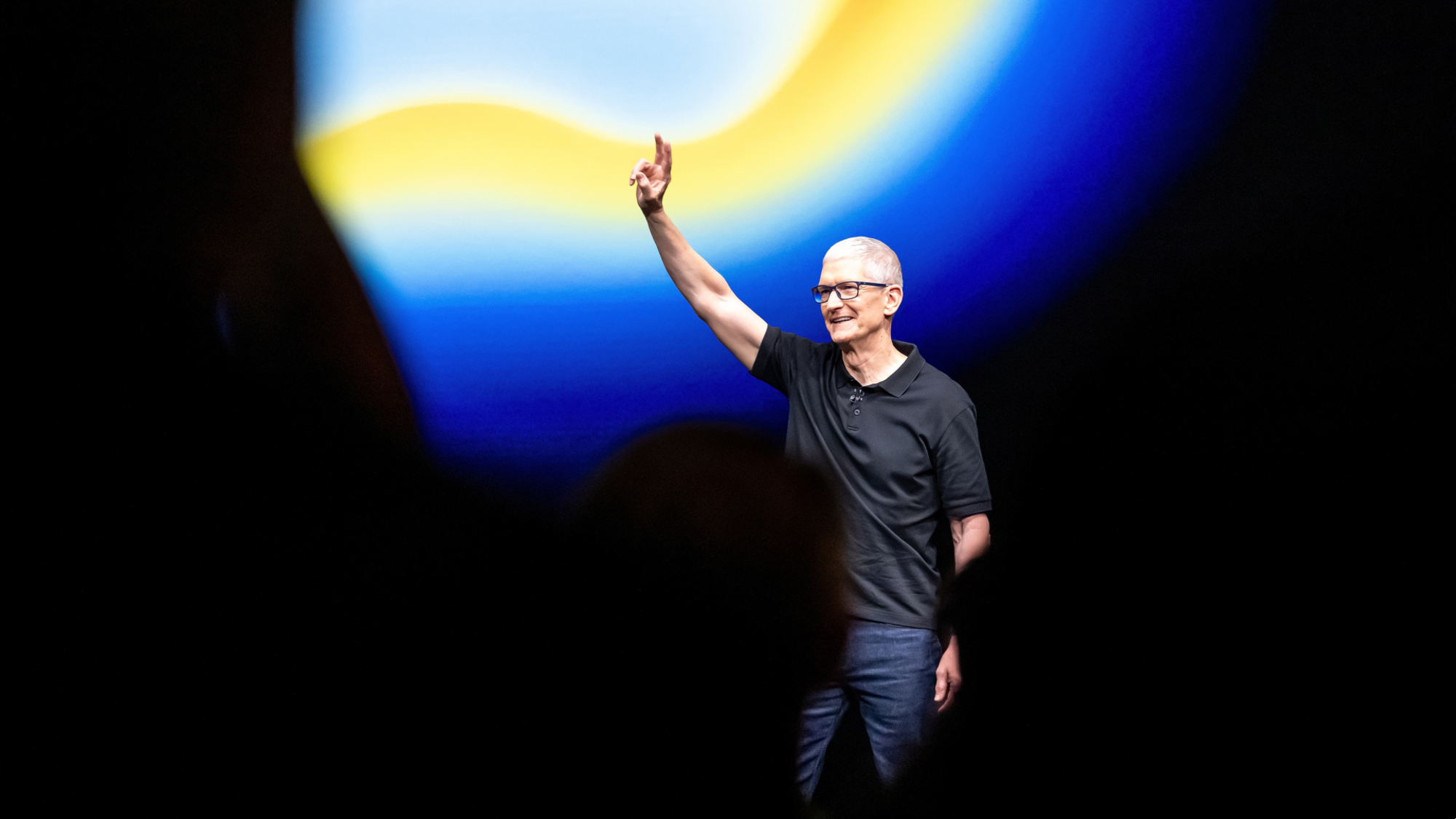 Is Apple’s Tim Cook about to retire?
Is Apple’s Tim Cook about to retire?Today's Big Question A departure could come early next year
-
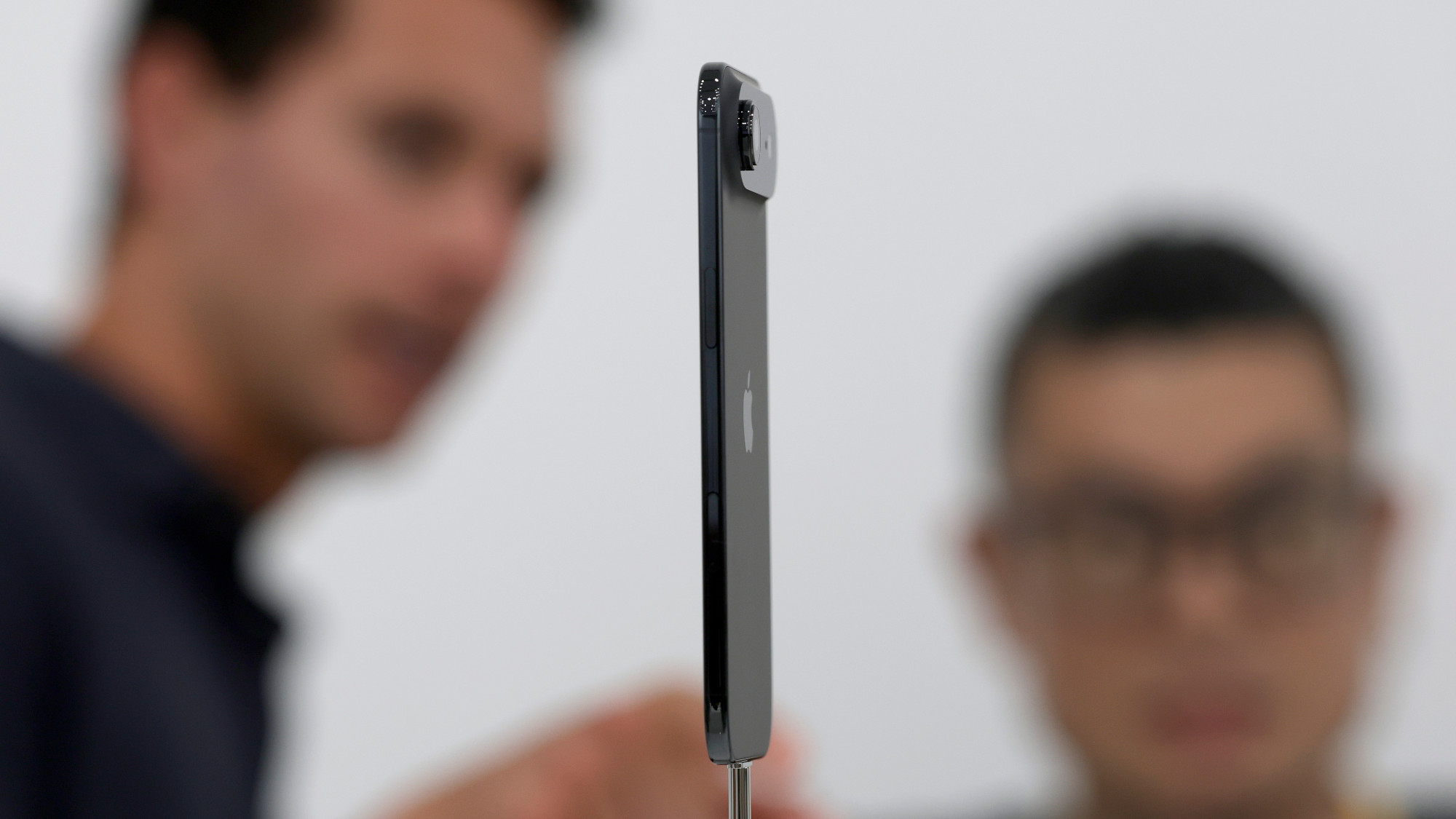 iPhone Air: Thinness comes at a high price
iPhone Air: Thinness comes at a high priceFeature Apple’s new iPhone is its thinnest yet but is it worth the higher price and weaker battery life?
-
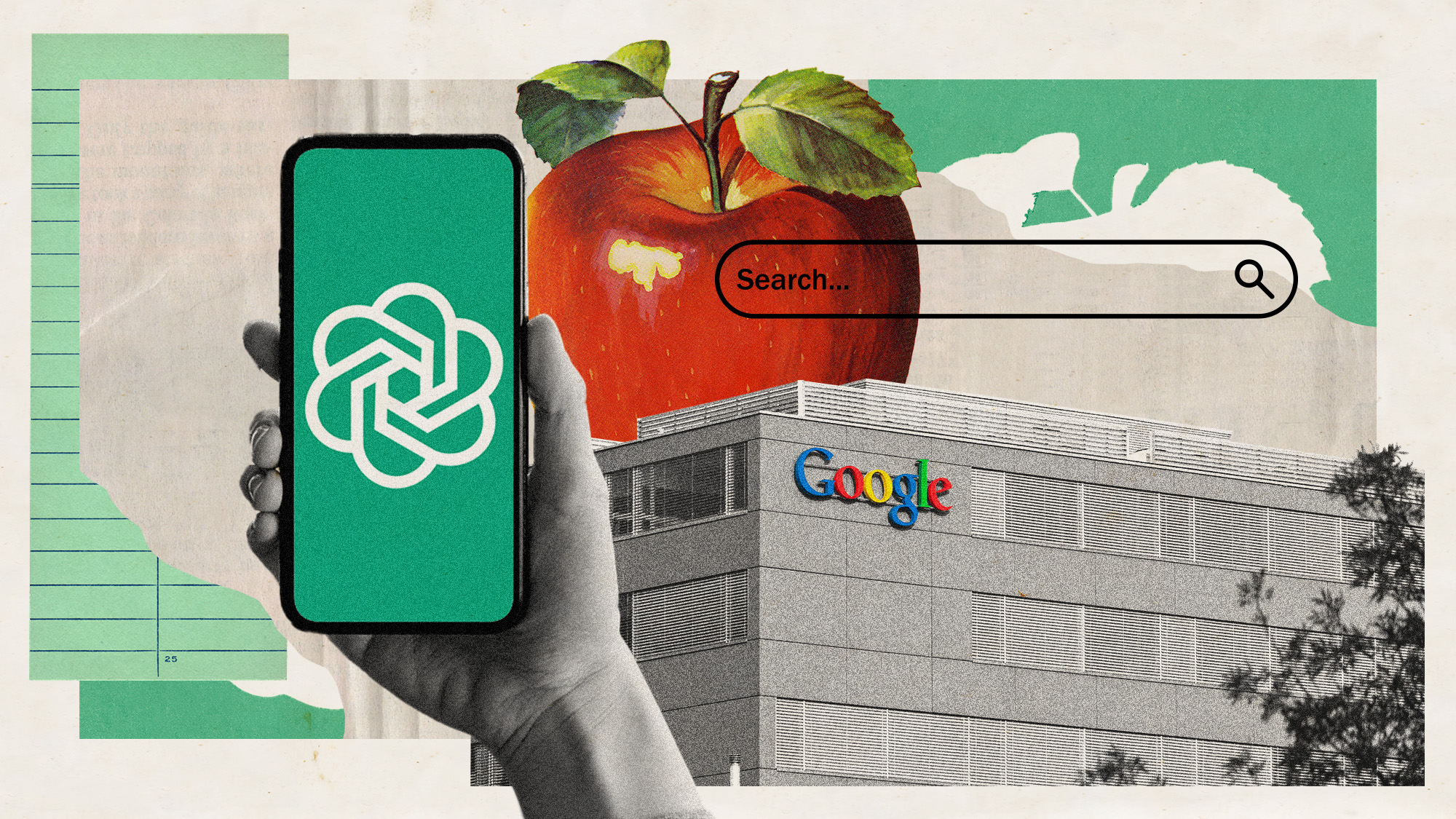 Is Apple breaking up with Google?
Is Apple breaking up with Google?Today's Big Question Google is the default search engine in the Safari browser. The emergence of artificial intelligence could change that.
-
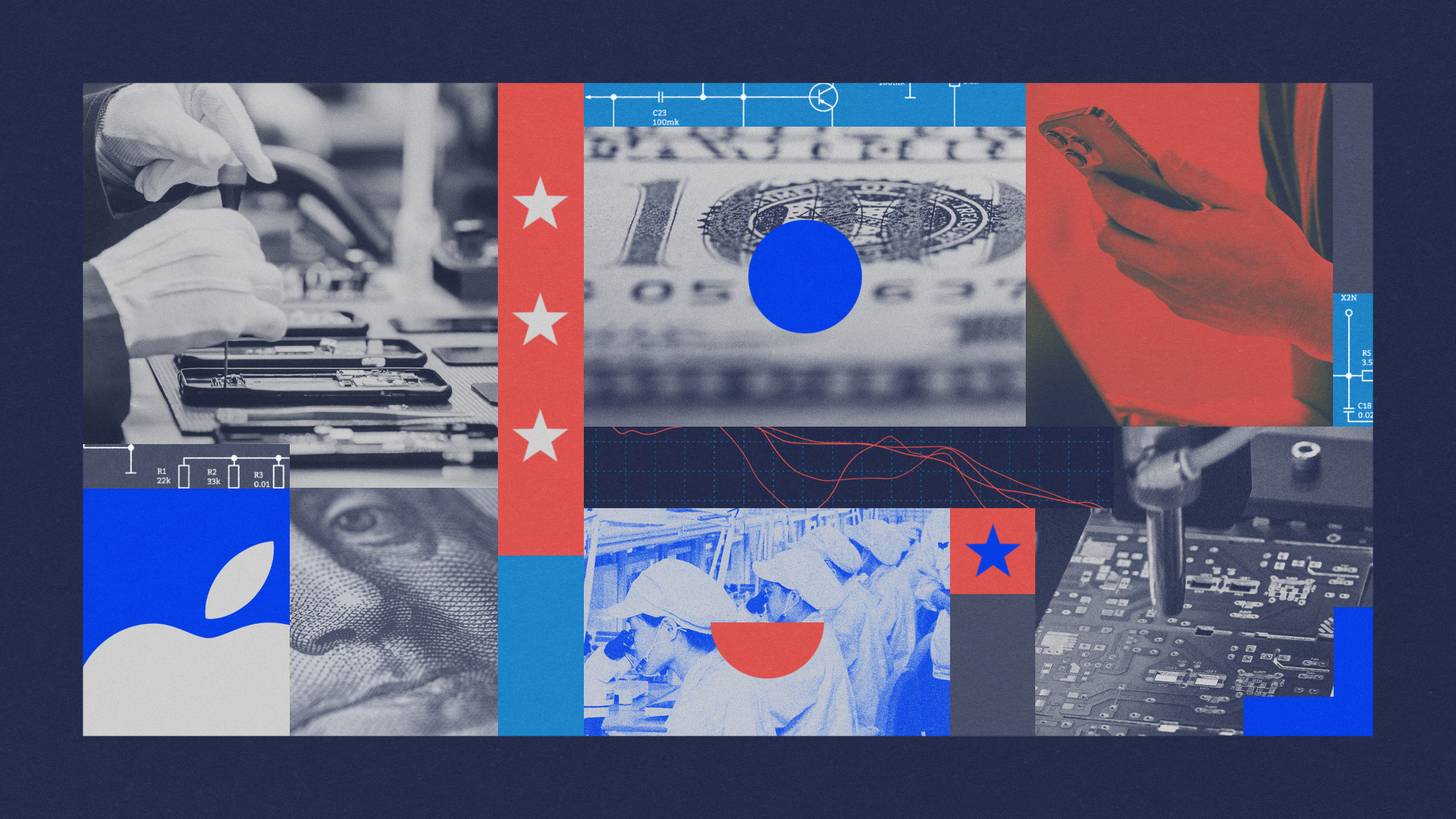 Why won't Apple make iPhones in America?
Why won't Apple make iPhones in America?Today's Big Question Trump offers a reprieve on tariffs, for now
-
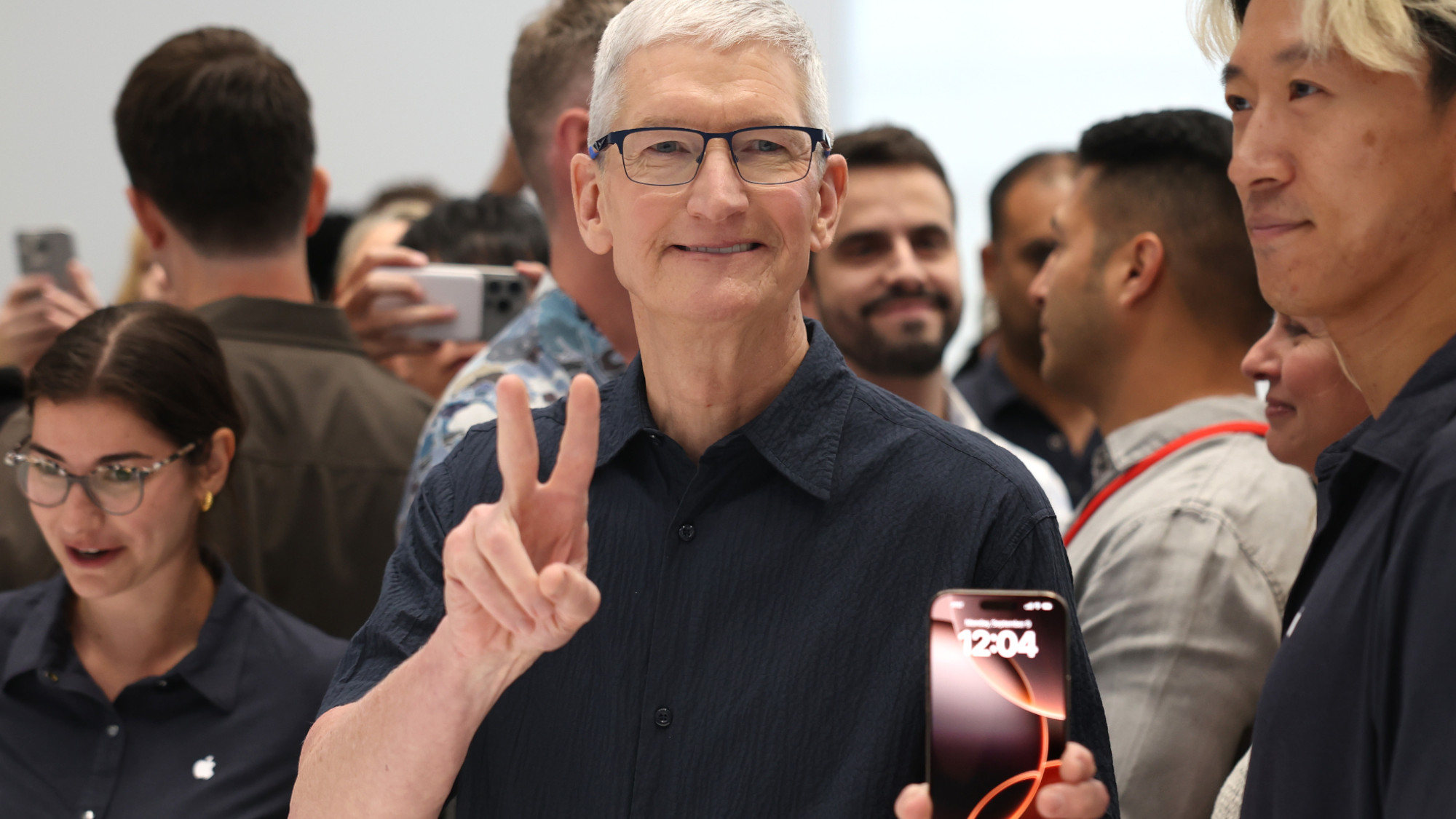 Not there yet: The frustrations of the pocket AI
Not there yet: The frustrations of the pocket AIFeature Apple rushes to roll out its ‘Apple Intelligence’ features but fails to deliver on promises
-
 Space-age living: The race for robot servants
Space-age living: The race for robot servantsFeature Meta and Apple compete to bring humanoid robots to market
-
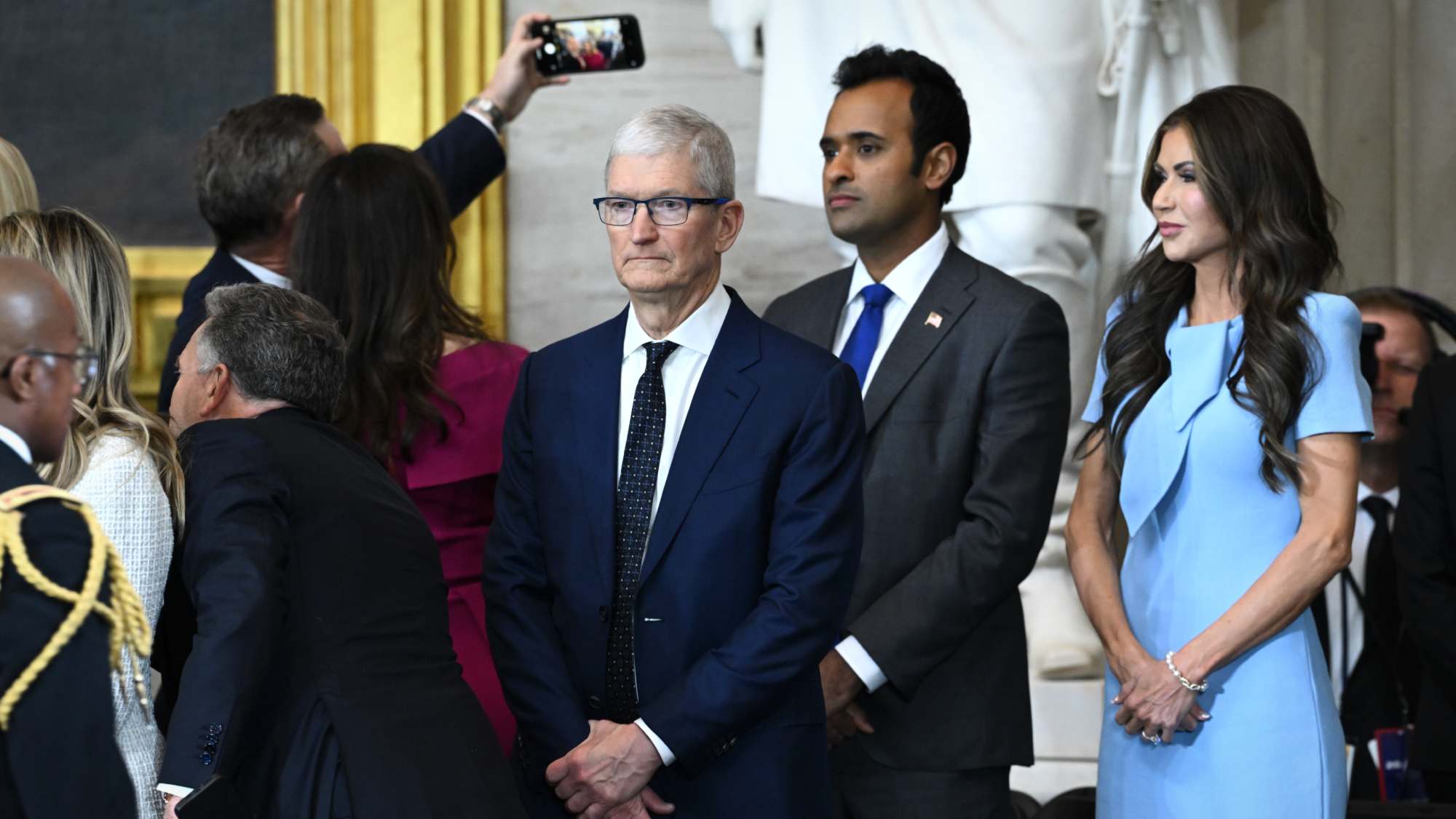 Apple pledges $500B in US spending over 4 years
Apple pledges $500B in US spending over 4 yearsSpeed Read This is a win for Trump, who has pushed to move manufacturing back to the US
-
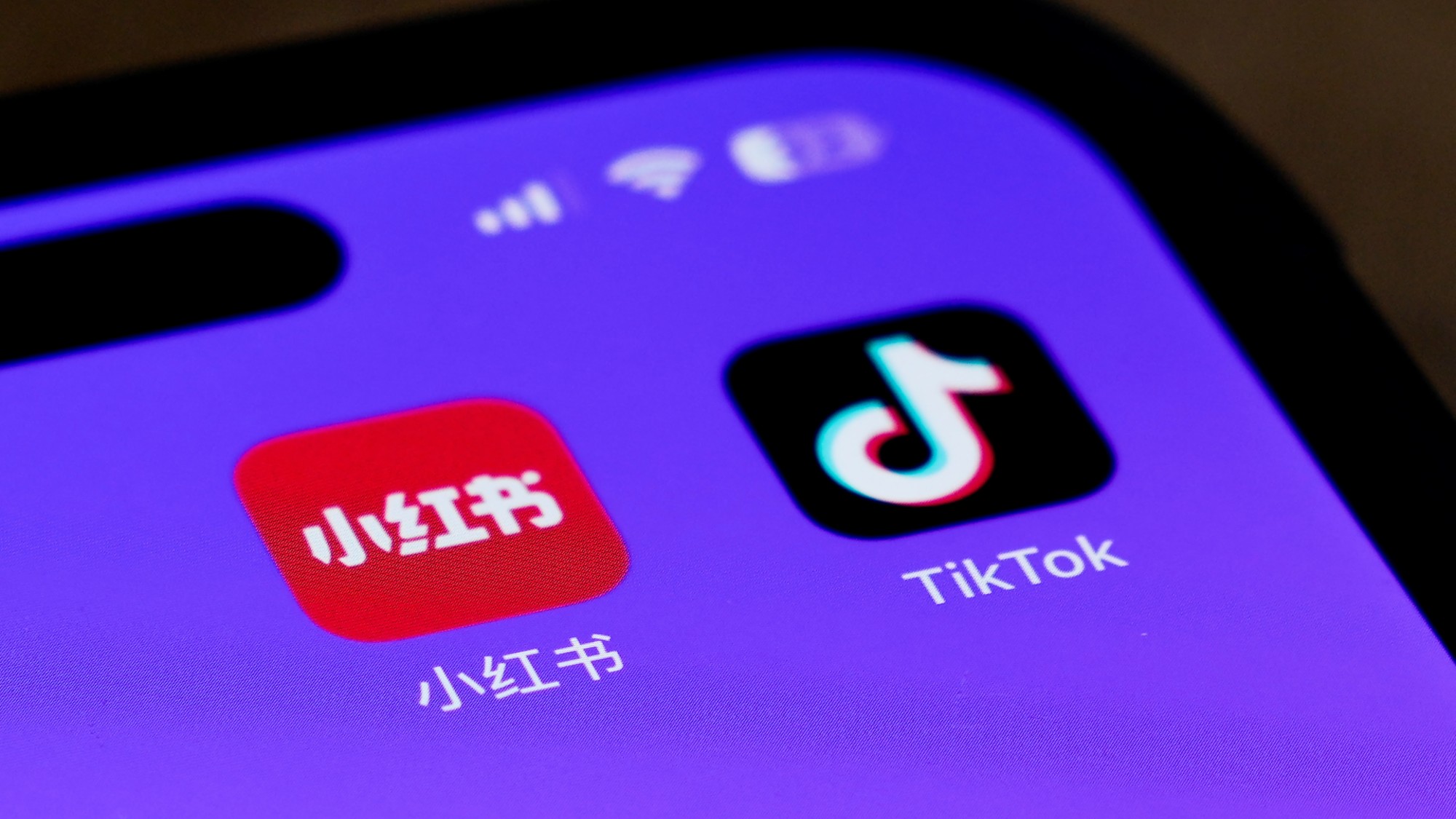 TikTok alternatives surge in popularity as app ban looms
TikTok alternatives surge in popularity as app ban loomsThe Explainer TikTok might be prohibited from app stores in the United States